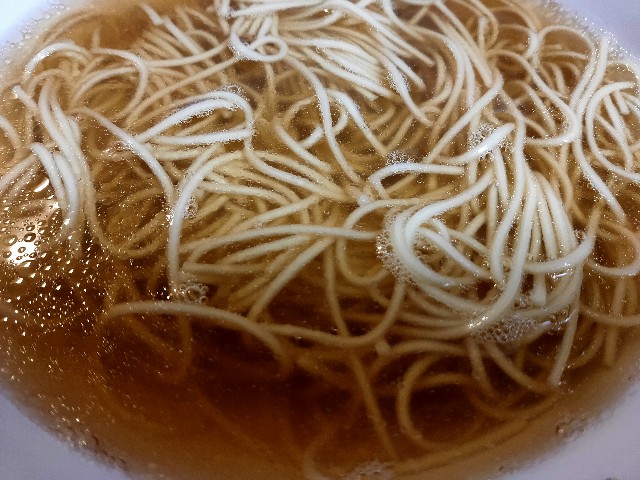Clear tonkotsu ramen, the origin of tonkotsu ramen, has recently come back into the spotlight. I decided to make the so-called blue hot spring soup. The method and ingredients are almost the same as regular tonkotsu ramen. The difference is the heat level. Tonkotsu ramen is generally cooked over high heat for a long time. When making transparent tonkotsu ramen, use low heat. This prevents the soup from becoming cloudy.
A completely clear, transparent soup.
After simmering for 8 hours, the tonkotsu ramen is clear, and you can see the bottom of the ramen. When I tasted it,

It tastes like tonkotsu, but the broth is weak. The fear of cloudiness made the heat too low, and it seems I couldn't extract the pork's umami properly. Let's try simmering it a little longer with higher heat.
透明 (Transparent): Clear or see-through, often used to describe liquids or materials that light can pass through.
とんこつラーメン (Tonkotsu Ramen): A type of Japanese noodle soup made with pork bone broth.
元祖 (Originator): The original or first of something.
脚光 (Spotlight): Attention or focus, often in the context of media or popularity.
澄んだ (Clear): Free from cloudiness or impurities.
青湯 (Blue Hot Spring Soup): A term used to describe a clear soup in Japanese cuisine.
作り方 (Method): The way something is made or constructed.
材料 (Ingredients): The components or materials used to make something.
火加減 (Heat Level): The control of heat in cooking.
一般的 (Generally): Commonly or typically.
強火 (High Heat): A high level of heat used in cooking.
長時間 (Long Time): An extended period.
弱火 (Low Heat): A low level of heat used in cooking.
濁らない (Not Become Cloudy): To remain clear and not become mixed with impurities.
濁っていない (Not Cloudy): Free from cloudiness or murkiness.
底 (Bottom): The lowest part of something.
完成 (Completion): The act of finishing or completing something.
味 (Taste): The sensation of flavor perceived in the mouth.
出汁 (Broth): A liquid in which meat, fish, or vegetables have been simmered, used as a base for soups or sauces.
弱い (Weak): Lacking strength or intensity.
恐れて (Fear): To be afraid or scared of something.
豚 (Pork): The meat from a pig, used in various cuisines.
旨味 (Umami): A basic taste sensation that is meaty or savory, considered one of the five basic tastes.
抽出 (Extract): To remove or take out, especially by effort or force.
少し (A Little): A small amount or degree.
さらに (Further): Additional or more.
煮込んで (Simmering): To cook something slowly in liquid just below the boiling point.
豚そば (Pork Soba): A type of Japanese noodle dish made with pork.
月や (Tsukiya): Possibly a name or brand associated with the dish.
クリア豚骨ラーメン (Clear Pork Bone Ramen): A specific type of ramen made with a clear pork bone broth.
